Six North Faces of the Alps: the Eiger
Our adventures are on hold at the time of writing, with lockdowns and Covid-19 mitigation meaning that none of us are doing what we imagined we might be this winter.
So we’ve asked IFMGA Mountain Guide and Glenmore Lodge Instructor Stuart McAleese to share his experiences of climbing the six classic North Faces of the Alps. Who doesn’t need a bit of armchair inspiration right now?
A very big thanks must also be given to British Mountain Guides John Orr and John McCune for allowing us to use the photos you see in this post.
.
The North Face of the Eiger,
Stuart McAleese IFMGA
.
“Reflecting right now and looking towards future goals whilst sitting out the latest lockdown, it is a pleasure to write this article. The classic North Faces of the Alps are many Alpinists dream. The history, the lore and the pull of the European Alps……it is timeless. Over the next few weeks I’ll share some of my stories, thoughts and experiences from each classic Alpine North Face with you.
.
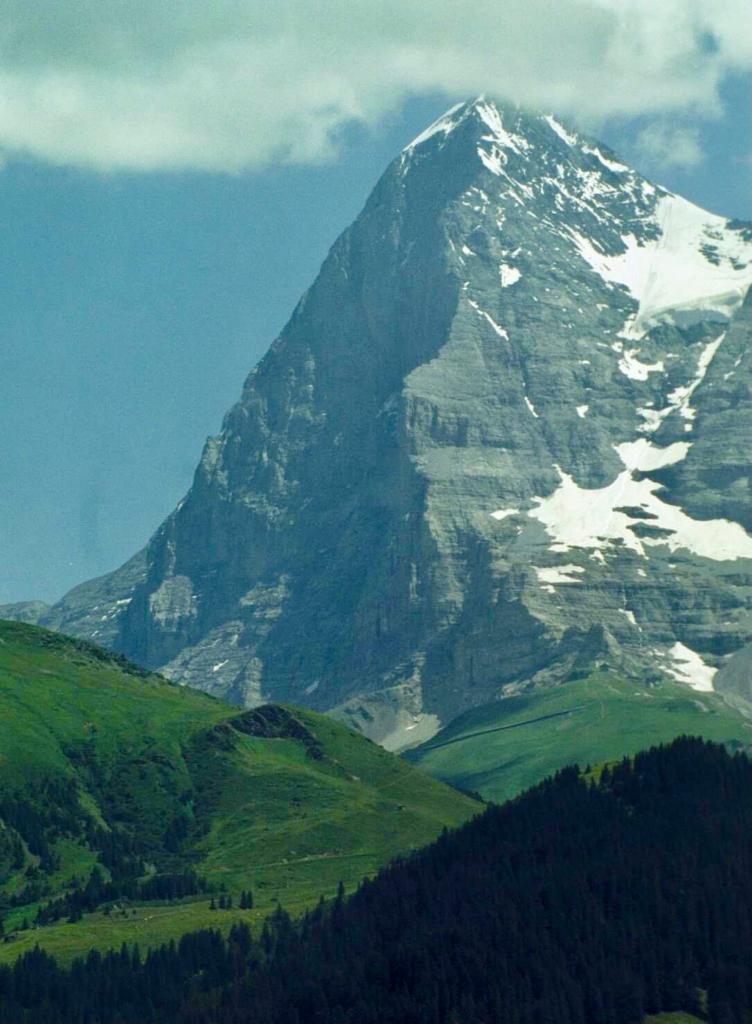
The Eiger in Summer. Photo credit John Orr IFMGA Mountain Guide
.
I’ve been lucky enough to have climbed the six classic North Faces of the Alps and in some cases twice over on different routes and in different seasons.
All the stars need to align for these big routes to be an option. Being in the right place at the right time, a total hero friend for a climbing partner, and a bit of luck too.
It’s never easy climbing a big North Face in the Alps and its always memorable. Each climb has provided some of the biggest and best moments I’ve had in the mountains. Climbing these big North Faces draws upon all your resilience, your mountaineering ability, experience and the combined skills of the team. Having a good friend as a hero climbing partner is key and makes for a strong team, safe and a fun time.
I always feel a little nervous before a big route, but this is a good thing! I see it as test of commitment and recognition of the challenge that lies ahead, knowing what kind of adventure and pain and discomfort is about to happen. Each challenge and climb helps you build pace and endurance, helping you build on each achievement. All of this is important because the North Face routes are committing and can go on forever.
There’s also the aesthetics. All the six North Faces are stunning to look at and offer some of the biggest mountain features in the Alps. Their sheer size and how hostile they look is impressive.
Then there’s the history. When you are on these North Faces you are climbing through history.
The swallows nest, death bivouac, traverse of the gods, the white spider; so evocative. When they were first climbed all of these routes represented some of the most important ascents in the world’s climbing history.
.
.
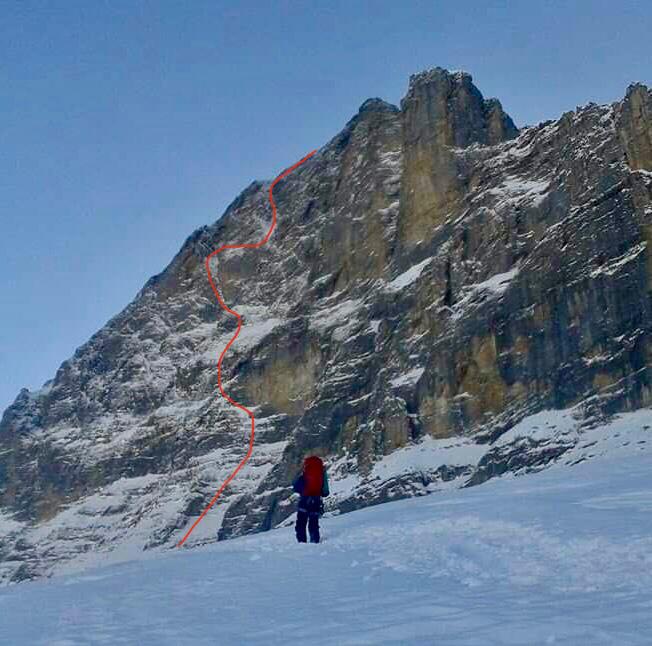
The Eiger. Photo taken by John Orr IFMGA Mountain Guide on his ascent
.
.
The Eiger North Face:
1938 route
Time taken: 4 days
Climbing partner: Mike ‘Twid’ Turner (total hero, climbing legend and IFMGA Mountain Guide)
When: March 2002
.
Trip Report
.
I had 2 weeks off work and we were in Chamonix, resting up having just climbed a couple of routes – ‘Beyond Good and Evil’ on Les Pelerins and the ‘Modica-Noury’ on Mont Blanc du Tacul.
Thinking of what to do next we looked at the forecast and saw Grindelwald had 5 days of sun and stable weather, and the Eiger North Face idea started to grow.
We did some quick research and spoke with some people in Grindelwald. We then gave ourselves the day to drive over and continue to rest and recoup from the few days out climbing in Chamonix. I remember having to dry my washing out in the car on the drive over to Grindelwald, socks and gloves all over the place and really hoping they would dry in time.
On arrival in the village, we sorted our accommodation for the night and went to have a clearer look at the North Face, to see conditions and how much snow there was on the route.
The view of the mountain is unbelievable. The village sits in the meadows and valley below the North Face, so it dominates and feels incredibly close.
This was pre-Facebook and generally before any of the internet mountain updates we’re now used to, so we had very little intel other than a good forecast and speaking to locals in Grindelwald. It was late March and it felt like spring. There was still a lot of snow in the mountains. We were packing for an expected 5 days max food and fuel to climb the face and get off.
The night before we went out for some food in the village, and on opening the huge chunky wooden door to the bar I pulled it at full force into my forehead…. stylish I know. Creating a bruise right in the middle of my forehead, this hurt, but not as much as the helmet pressing on it over the next few days…
That night we talked over tactics and struggled to find good topos, so in the end we took anything we could find – even a postcard from the train station in Grindelwald.
.
The Climb
Pretty nervous and after little sleep, we got the first train up to Kleine Scheidegg. Here the train station and village was deep in snow and quiet. We got off the train a little higher and started the walk under the North Face to the base of the wall.
With heavy rucksacks we waded up the lower slopes, this was heavy going and waste deep at times. Wondering if we were doing the right thing, we slowly kept going, each taking turns to break trail, running out long rope pitches on easy ground, but deep cold snow. After a few hours of this the ground ahead got steeper and we were able to climb with less snow, and our next challenge was to route find and recognise features such as the ‘shattered pillar’ and the ‘difficult crack’. Recognising these features would reassure us that we were on the right track. We kept pace, as it was getting later in the day and we were aiming to bivouac at the Swallows nest.
To do so, we had to find the famous Hinterstoisser traverse, a key section which would unlock the rest of the route. Route finding here was quite tricky – at this point the terrain all around us felt steep and unobvious. It was my pitch next.
I was getting tired and the day was getting on. We really needed to make progress. I climbed up to a wall and had a look around the corner and there it was; I could see the Hinterstoisser traverse!
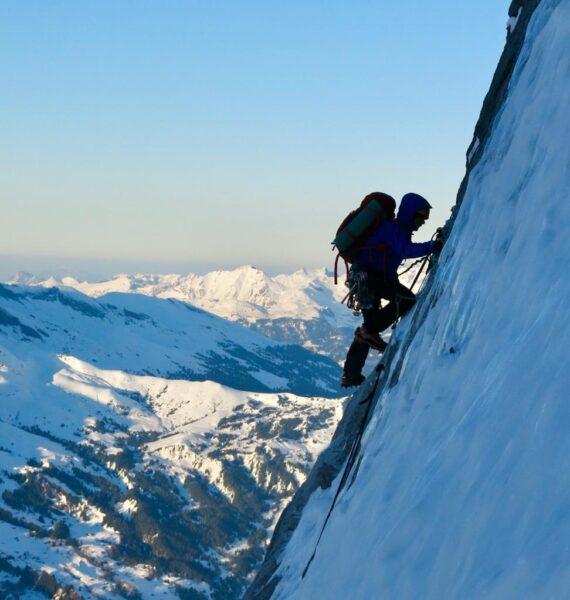
Credit: IFMGA Mountain Guide John Orr. The Hinterstoisser traverse
.
I remember what looked like a few old ropes fixed along a difficult and exposed featureless slab, I quickly clipped to these and started pulling myself across, My crampons scratching on the rock as I tried carefully to use tiny footholds, feeling pretty heavy committing to the collection of knackered old looking ropes… I didn’t care to think too much and totally trusted the ropes. Twid shouted from around the corner…. how’s it going? I replied…I’m on the Hinterstoisser traverse!! At which point I thought wow! I’m actually here. This traverse named after famous climbers who were pushing boundaries; embedded in Alpine climbing history and I did not feel worthy.
I kept going and knew the bivouac ledge was just beyond this, the ‘Swallows Nest’. Once at the little cave, we dug the snow away to create a big enough ledge to sleep on, and jumped into the sleeping bags, melted snow for water and had some food. We were tired and relieved that we had made it to this bivi ledge. It quickly got dark and we could see the lights from Grindelwald down below.
Waking up there was a lot of admin to get going. The route sat back from our current location, but we could see clearly where to go. What followed next was steep ice on the ‘ice hose’ pitches, then the 1st and 2nd snowfields, conditions for us that day delivered hard ice in places, which made for insecure, slow going. I remember trying to concentrate and move quickly, feeling exposed to possible ice and rockfall crossing the snowfields.
Little rocks and bits of ice zipped past in the air, caused by the morning sun creating melt high on the face. You could see the ice was peppered in places, from previous rock fall.
Once we made it above the ice fields we were sheltered under the huge headwall of the Eiger. We paused at ‘death bivouac’ and could clearly see ‘the ramp’ section above. This had many sections of technical ice/mixed climbing in little gullies and runnels hanging high above the North Face.
It was still good weather but cold and I can remember putting a karabiner in my mouth and my lips quickly freezing to it, at which point I ripped it out along with it a load of skin. Now I was spitting blood all over the snow…note to self!
.
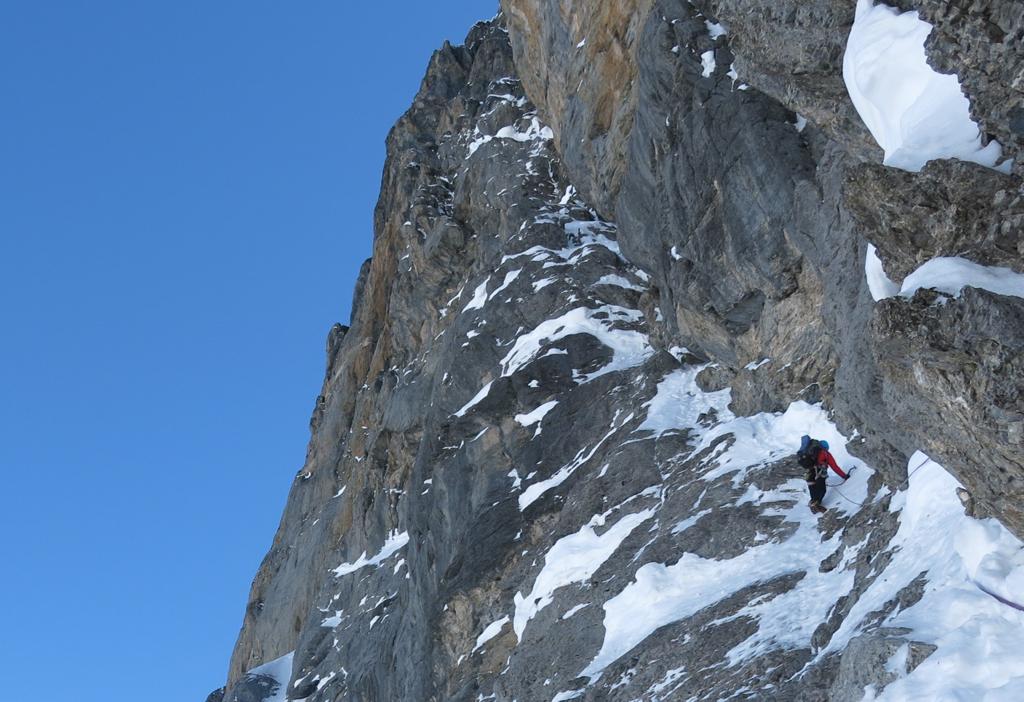
Credit: IFMGA Mountain Guide John McCune. The Ramp
.
We were feeling good and aiming to get to the ‘Traverse of the Gods’ before dark, as there was meant to be a good ledge there to bivouac on for the night, but before this we had to climb the brittle ledges and the ‘brittle crack’.
Climbing up the brittle ledges was loose. So climbing slowly and as carefully as I could I turned, and my rope knocked off some rocks. That was it! And in that moment, I was convinced that they would hit Twid on the belay way below and I was terrified…I shouted…you ok? I was so happy when I heard him shout back that he was ok. This is a major reason why this face is now climbed mainly during colder and more snowy times of year like winter and sometimes a cold spring/autumn.
I remember at last pulling up the steep brittle crack to find the Traverse of the Gods.
Tired and pleased to stop for the day we took our bags off carefully and started digging the snow to make a ledge to sleep on. At this point we also knew we were low/running out of gas. It is possible that the cold had really drained the fuel on the previous night’s bivi. At the pace we were going we hoped we would summit the next day, but we were unsure, so running out of gas that evening was not ideal and would leave things tight if we had to spend another night out.
.
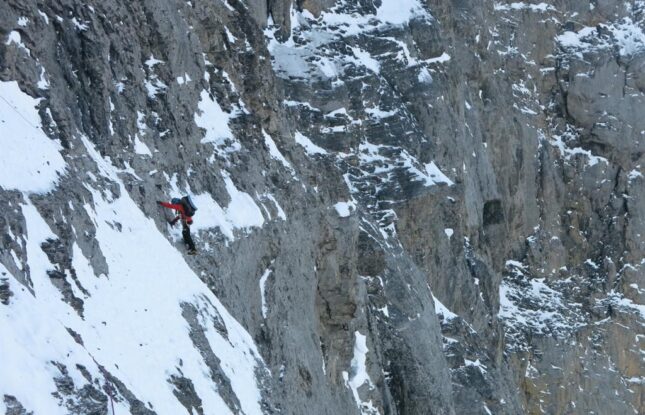
Credit: IFMGA Mountain Guide John McCune. Traverse of the Gods
What happened next was unbelievable and solved our gas problem….
On digging the snow with our ice axes to make a ledge, Twid hit something metal? What was that I asked? We couldn’t believe it…. he dug out of the snow the biggest Coleman gas cylinder you had ever seen! Maybe left behind by other climbers? Our gas supplies were saved! We smiled and couldn’t believe our luck! Both of us were happy now, we had enough gas for food and water for the next two days.
I remember getting into my sleeping bag tired and feeling warm with the evening sun on us, I pulled out my mobile phone and called friends to tell them how we were getting on, which was quite a novelty back then having outside contact with mobile phones in the mountains.
Our wake-up call that morning on day three was the ‘traverse of the gods’, a long and exposed traverse of snow and tiny foot ledges, way above the entire North Face.
We were careful and this went easier than we were expecting, leading us straight into the White Spider. The White Spider is a snow/ice field high on the face with many steep ice gullies spreading away from it, making the shape of a spider. We had hard black ice in sections again, but we were feeling strong and keen to summit that day. I remember passing a portaledge where tonnes of gear and ropes had been left behind near the top of the White Spider. I didn’t really want to think how and why that was left there as we climbed on passing the ‘Corti Bivouac’ to the exit gullies.
The route and mountain has many famous stories, epics and ghosts. It’s hard not to think of these and the history the mountain has as you climb past these notable sections. I always have respect for the climbers and the pioneering history they made and try not to think too much of all the epic stories this wall has. We pushed on to the exit gullies.
In the zone now and we both could feel the summit. We climbed the exit gullies and found ourselves on the summit ice field. The rucksack was feeling lighter now as we only had noodles and snack bars left for food and little gas too. Long rope out now climbing the summit snow slopes and pausing for breaks, resting your calf muscles and trying to pace yourself, as it felt like it went on forever.
Once at the summit ridge we could feel the evening sun and all we had to do now was traverse the knife edge snow ridge for about 200m to the summit. Tired and trying to stay focused, long rope pitches and moving together at times, we were careful when traversing the steep snow and ice on the crest of the ridge.
It was around 4pm when we arrived on to the summit, in the sun and off the cold dark North Face. We could feel the full warmth of the sun for the first time in 3 days.
A quick summit selfie (slide film back then by the way!), we took a moment to take in the view and consider the descent.
Tired and happy we had to keep moving, so pushed on down the West Flank, our descent route off the mountain. We were now mainly on mountaineering terrain, with some down climbing on snow with the odd rock step. We were being cautious at times due to fatigue and not wanting to make an easy mistake at this stage.
It was getting late and we knew we could not make it down that evening and rather than route finding in the dark we decided to look for another bivouac site. We found a nice little flat piece of ground on the ridge sheltered against a rock wall, when compared with the bivouacs we had on the North Face, this was five-star luxury accommodation for the evening.
The good weather was still holding and we had a comfortable night with the last remaining noodles and snack bars.
In the morning we were keen to get down. Tired and still happy we packed the sleeping bags away for the last time and kept our focus on descending/down climbing the final snow slopes to the base of the mountain and the little Eigergletscher train station.
It is hard to describe the feeling of arriving at the train station and the transition to normal life after a few days climbing the North Face felt strange.
It was still morning time and Twid was quick off the mark to get some food for us, and I’ll never forget that breakfast sitting at the train station, apple pie and a bottle of beer.
.
.
About Stuart McAleese
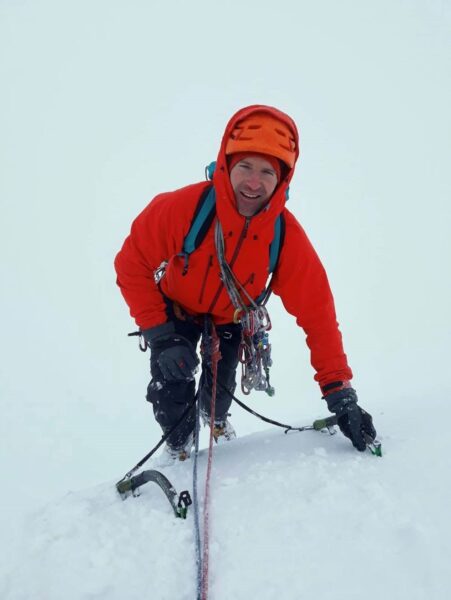
.
Originally from Northern Cumbria I started out hill walking in the Lake District when I was at school. I soon become interested in rock climbing and mountaineering, and was lucky enough to work and climb with Mountain Guides during my first job leaving school. Since then I’ve been working full time in the mountains for around 20 years.
At the same time as working, I enjoy climbing in my free time and have been lucky enough to go on many expeditions around the world, climbing new mountains, first ascents and tough remote summits. Places such as Patagonia, Alaska, Himalaya, Peru, Baffin Island, Yosemite and China. In 2004 I was nominated for the prestigious Piolet d’Or in Grenoble, France, for a 1st ascent of the ‘Supa Dupa Couloir’ in Alaska.
I love my job as a Mountain Guide, teaching and exploring big mountains in all weather all year round. I joined the Glenmore Lodge team in 2019.
.